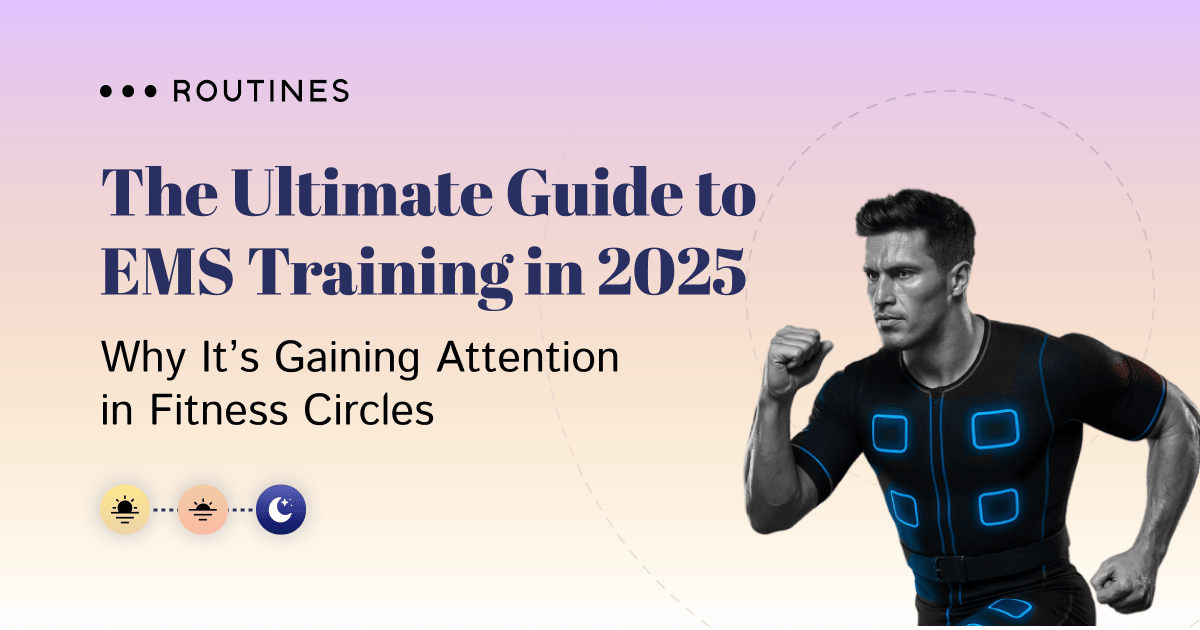- Routines
- Posts
- Can EMS Make Your Workout (and Routine) More Efficient?
Can EMS Make Your Workout (and Routine) More Efficient?
The Smart Hack for Burning More Calories in Less Time

Hello Health Optimizers,
This week, we’re exploring Electrical Muscle Stimulation (EMS) training, a method that’s changing how people build strength and recover faster. EMS sends gentle electrical pulses to activate muscle fibers, helping you burn more calories in less time. Simple, efficient, and backed by science, EMS can take your routine to the next level.

This meme is funny until you realize you’ve been in the same position. EMS training might be your fast track out.
In this week’s newsletter, we cover:
⚡ The science behind EMS and how it actually works
💪 Why EMS training is gaining serious attention
🧥 Can the Visionbody suit upgrade your workouts?
💊 Supplements that support muscle activation and recovery
🚨 What you need to know before trying EMS
📆 A weekly EMS routine for beginners, intermediates, and pros
What is Electro Muscle Stimulation (EMS) Training and What's The Science Behind It?
Electrical Muscle Stimulation (EMS( training, combines technology and muscle activation to enhance the effects of a workout. Instead of relying solely on traditional movement, it uses electrical impulses to trigger muscle contractions with more intensity.
How it works: Special pads or suits send controlled impulses directly to motor neurons. This makes muscles contract in a way that mimics intense physical activity, without the need for heavy lifting.
Smart equipment and settings: Modern EMS systems include wireless suits and devices that let users adjust frequency, strength, and timing to match personal goals. Top-of-the-line options, like the Visionbody EMS suit, even sync with apps for seamless control.
Deeper muscle activation: EMS focuses on fast-twitch fibers (Type II), the ones responsible for explosive strength and power. These fibers don’t normally get used until you're lifting heavy but EMS brings them into action sooner.1
Efficiency for recovery and strength: It’s not just about working out harder. EMS is used for targeted rehab, muscle re-education, and enhancing performance during basic movements or while standing still.
Science-backed results: EMS can lead to better muscle recruitment, higher calorie burn, and improved circulation. MicroRNA shifts and enhanced energy use help explain the long-lasting effects users often report, even after short sessions.
This blend of tech and training is ideal for people with tight schedules who want better results in less time. As more professionals look for smarter fitness tools, EMS is becoming a powerful part of the modern routine.
Benefits of EMS Training
EMS training isn’t just a fitness shortcut, it’s a science-backed way to level up your results with less time and strain. Whether you’re aiming for strength gains, injury recovery, or a more sculpted body, EMS offers several key advantages that make it stand out from traditional workouts.
Faster Muscle Growth: EMS training can increase muscle mass more quickly than regular resistance workouts. It may boost gains in just a few weeks when combined with strength training.
Strength Without Heavy Lifting: EMS activates fast-twitch muscle fibers earlier, which are usually recruited during intense weightlifting. This helps improve strength, even in people with limited movement or joint issues.
Improved Recovery Support: EMS is often used in physical therapy because it helps maintain or rebuild muscle strength during rest periods. It also boosts blood flow, which can speed up recovery and reduce soreness.
Fat Loss and Body Shaping: EMS training helps reduce visceral fat and preserve lean muscle during calorie deficits.
Time-Efficient Workouts: Sessions typically last just 20–25 minutes while delivering results similar to traditional workouts that take over an hour. This makes it easier to stay consistent, even with a packed schedule.
Less Wear on Joints: Because EMS uses controlled electrical impulses instead of external loads, it puts less strain on joints and connective tissues. That makes it ideal for people with injuries or those looking to avoid long-term wear and tear.
Accessible Anywhere: With wireless suits and app-based platforms, EMS training can be done at home, in a studio, or even outdoors. No bulky machines or heavy gym equipment required.
EMS training is a smart option for anyone who wants to work out smarter, not harder. It blends effectiveness, convenience, and recovery into one tool that supports both fitness progress and everyday balance.2
Visionbody EMS Suit
The Visionbody EMS suit brings a modern, high-tech edge to EMS training by making the experience wireless, app-controlled, and more targeted than ever. With a full-body design and user-friendly features, it helps users maximize results while staying comfortable and mobile during every session.
Smart pad setup for full-body training: The suit features 24 EMS pads built directly into the fabric, allowing simultaneous stimulation of all major muscle groups. This design enables full-body workouts without the need to switch attachments or reposition equipment.
Focus on hard-to-train areas: It’s especially useful for targeting muscles that often get overlooked, such as the inner thighs, calves, neck, and shoulders. These zones benefit from improved circulation and activation, which may support better muscle tone and tension relief.
Wireless system and easy charging: With no wires to manage, users can move freely while training. The suit includes a long-lasting battery that connects via USB-C and can be quickly swapped for regular use with minimal hassle.
Integrated tracking and mobile control: The built-in heart rate sensors sync with an app, allowing users to adjust intensity levels and follow personalized workout plans. Whether you're training for recovery or performance, the system adapts to your specific goals.
By combining technology and comfort, the Visionbody EMS suit helps users get more out of every session, making it easier to stick to routines and see real progress, no matter the training focus.
Supplements That Complement EMS Training
Supplement | Why | Dosage & Timing | Purchase Link |
|---|---|---|---|
Whey Protein Isolate | Rapid amino‑acid delivery for post‑EMS muscle repair | 20–30 g within 30 min post‑session | |
ZMA | Supports overnight recovery, sleep quality, and hormone balance | 1 serving (per label) 30–60 min before bed | |
Creatine Monohydrate | Boosts phosphocreatine stores for greater strength & power output | Loading (opt.): 20 g/day split ×4 for 5–7 days; Maintenance: 3–5 g/day (anytime; post‑workout with carbs ideal) | |
BCAAs | Stimulate protein synthesis & reduce soreness | 5–10 g during or immediately after EMS session | |
Beta‑Alanine | Buffers muscle acidity to delay fatigue | 2–5 g/day, split into smaller doses (to minimize tingling) | |
Electrolytes | Maintain fluid balance & proper muscle function | Use electrolyte powder/tablet before & after training. | |
Omega‑3 Fish Oil | Anti‑inflammatory support for recovery & joint health | 1–3 g EPA+DHA per day with meals | |
Vitamin D3 | Supports muscle function, immunity, & bone density | 1,000–4,000 IU/day (based on serum levels) | |
L‑Citrulline Malate | Boosts nitric oxide production, improving blood flow and endurance without stimulants | 6–8 g 30–60 min before EMS session |
EMS Implementation Strategies
To get the most out of EMS training, proper setup is just as important as the workouts themselves. From health assessments to choosing the right equipment, following a structured approach ensures both safety and long-term success with EMS fitness routines.
Medical clearance before starting: A full health check helps identify risk factors, review past injuries, and confirm readiness for EMS. Getting physician approval is essential, especially for those with medical conditions or a history of injury.
Initial fitness assessment: Measuring movement, flexibility, and strength helps set a baseline before starting. This step also defines personal goals and ensures the program is customized for individual needs.
Slow and steady progression: EMS sessions should begin with short durations and low intensity. Even fit users benefit from easing in slowly, giving the body time to adapt to electrical stimulation.
Tracking and feedback systems: Using tools to log results, adjust intensity, and gather user feedback ensures continued progress. It also helps trainers and users understand what’s working and where changes are needed.
A thoughtful, step-by-step approach to EMS setup builds a strong foundation for success. With the right strategy, users can safely integrate EMS into their routines and stay consistent over time.
Risks and Safety Considerations
While EMS training offers unique benefits, it's not risk-free. Certain medical conditions, medications, or even training errors can increase the chance of complications. Understanding who should avoid EMS and how to use it safely is essential for getting results without harming your body.
Absolute health risks: People with implanted pacemakers, defibrillators, neurological disorders, or active tumors should not use EMS at all. It can interfere with medical devices, trigger seizures, or stimulate unwanted cell activity.
Pregnancy and recovery issues: EMS should be avoided during pregnancy and during recovery from illness or surgery. The stimulation could affect abdominal and pelvic areas or delay healing.
Relative conditions needing caution: Individuals with diabetes, heart problems, kidney issues, or skin sensitivities must proceed carefully and with medical supervision. These users may need modified intensity and placement to avoid complications.
Medication interactions: Blood thinners, muscle relaxants, and some heart medications may alter how the body responds to EMS. Always consult a healthcare provider before starting EMS while on medication.
Severe muscle stress risk: If used incorrectly—such as starting with high intensity or skipping rest—EMS can cause rhabdomyolysis, a rare but serious muscle breakdown condition.
Warning signs to watch: Fatigue, headaches, dark urine, or flu-like symptoms after a session are red flags. Stop training and seek medical help immediately if these occur.
Basic safety habits: Hydrate well, eat a carb-rich snack a few hours before training, and start with low intensity. Rest between sessions is crucial for recovery.
Staying safe with EMS training comes down to listening to your body, getting medical clearance, and using a slow, step-by-step approach. When in doubt, always prioritize safety over speed.
EMS Training Routine
Beginner Routine (Weeks 1–4)
For those just starting out, the first few weeks of EMS training are about building comfort and safety. The focus is on learning proper form, using lower intensity, and gradually preparing the body for future sessions.
Frequency Settings: Use a frequency between 20 and 40 Hz to activate slow-twitch muscle fibers, helping reduce strain and support adaptation.
Workout Duration: Limit sessions to 15–20 minutes. Start with 5 minutes of low stimulation, then alternate 4-second impulse and rest periods.
Weekly Schedule: Stick to one session per week during the first 8 to 10 weeks to allow time for muscle recovery and minimize risk of injury.
Effort Control: Keep perceived intensity at a moderate level (4 to 5 on the Borg CR10 scale), checking effort at least three times during each session.
Movement Selection: Include simple moves like squats, planks, lunges, and isometric holds to stay within safe limits until muscle coordination improves.
This phase helps create a strong base by easing the body into EMS training and teaching proper responses to electrical stimulation.
Intermediate Plan (Weeks 5–8)
Once you’re comfortable with the basics, you can begin increasing difficulty safely. The intermediate stage builds muscle coordination and strength while keeping safety at the forefront.
Higher Frequencies: Raise stimulation to 50–70 Hz to better activate fast-twitch fibers, increasing training intensity gradually.
Longer Sessions: Extend training time to 20–25 minutes with longer impulse durations of up to 6 seconds, paired with 2–3 second rest periods.
More Frequent Training: Increase frequency to 1–2 sessions per week, ensuring at least 4 full rest days between workouts.
Greater Intensity: Bump effort up to 5 or 6 on the Borg scale. Ensure proper body control and communication with trainers before doing so.
Advanced Movements: Introduce more complex moves, like sport-specific drills or multi-joint exercises, once coordination improves.
This progression phase bridges the gap between beginner basics and more advanced EMS workouts, promoting safe gains in power and stamina.
Advanced Protocol (Weeks 9+)
Once EMS users have developed control, coordination, and recovery habits through the earlier stages, they can begin advanced training. This level is designed to maximize strength and performance but must be approached with care.
High-Frequency Stimulation: Increase the frequency to 75–85 Hz to target fast-twitch muscle fibers and enhance strength output. Pulse width may also be adjusted to 350–400 microseconds for deeper muscle activation.
Intensive Workouts: Sessions can now run 20–30 minutes. Extend impulse durations up to 8–10 seconds, paired with shorter rest windows to boost training density and challenge endurance.
Limited Frequency: Stick to 1–2 sessions per week with four full days of rest in between to prevent overtraining and promote muscle recovery.
Maximum Intensity: Push perceived effort to 7 or 8 on the Borg scale. This high level of difficulty should only be attempted under professional supervision to avoid injury.
Performance-Based Movements: Add explosive exercises, sport-specific drills, and high-level coordination tasks once control and muscle conditioning are fully established.
Advanced EMS training delivers significant performance benefits, but it demands strict safety checks, structured recovery, and guidance from professionals to be sustainable long-term.
What did you think of this breakdown of EMS training? |
What’s Happening @ Routines.club?
4-Week EMS Training Plan for Busy Professionals |
Methylene Blue Guide: Benefits, Dosages & Safety |
Join the Routines Revolution!
You don’t need hours in the gym to see results. EMS training focuses on working smarter, not just harder. It’s efficient, science-backed, and built for busy people who still want serious gains. If you're tired of routines that waste time and energy, follow us on Instagram for habits that actually work.
We break down workouts, recovery, and tech-enhanced training to help you burn more, recover faster, and stay consistent without the stress.
No hype. No guesswork. Just better training, one smart routine at a time.
The Routines Team
Affiliate Disclosure: This newsletter contains affiliate links. If you make a purchase through these links, we may earn a commission at no additional cost to you. Your support helps us continue to provide valuable content. Thank you!

